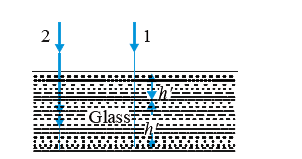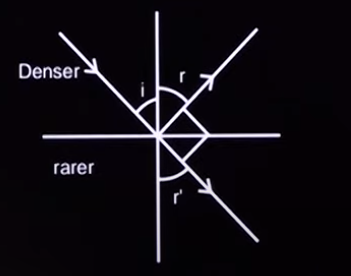Discuss why in diffuse reflection, reflected rays with varying angles of reflection are scattered out in all directions.
Step-by-Step Solution
1. Understanding Diffuse Reflection:
- Diffuse reflection occurs when light strikes an irregular or rough surface. Unlike a smooth surface, which reflects light in a uniform direction, a rough surface scatters light in many directions.
2. Surface Irregularities:
- An irregular surface has many different orientations at various points. This means that if we were to draw a normal line (a line perpendicular to the surface) at different points on the surface, these normal lines would not be parallel to each other.
3. Angle of Incidence:
- The angle of incidence is the angle between the incoming light ray and the normal line at the point of incidence. Since the normals are not parallel, the angle of incidence will vary at different points on the surface.
4. Angle of Reflection:
- According to the law of reflection, the angle of reflection is always equal to the angle of incidence. Therefore, if the angle of incidence varies, the angle of reflection will also vary accordingly.
5. Scattering of Light Rays:
- When parallel light rays strike the rough surface, they will reflect at different angles due to the varying angles of incidence. As a result, the reflected rays scatter in all directions rather than reflecting uniformly.
6. Conclusion:
- The combination of irregular surface features and the law of reflection leads to the scattering of light rays in diffuse reflection. This is why reflected rays with varying angles of reflection are scattered out in all directions.
- Diffuse reflection occurs when light strikes an irregular or rough surface. Unlike a smooth surface, which reflects light in a uniform direction, a rough surface scatters light in many directions.
- An irregular surface has many different orientations at various points. This means that if we were to draw a normal line (a line perpendicular to the surface) at different points on the surface, these normal lines would not be parallel to each other.
- The angle of incidence is the angle between the incoming light ray and the normal line at the point of incidence. Since the normals are not parallel, the angle of incidence will vary at different points on the surface.
- According to the law of reflection, the angle of reflection is always equal to the angle of incidence. Therefore, if the angle of incidence varies, the angle of reflection will also vary accordingly.
- When parallel light rays strike the rough surface, they will reflect at different angles due to the varying angles of incidence. As a result, the reflected rays scatter in all directions rather than reflecting uniformly.
- The combination of irregular surface features and the law of reflection leads to the scattering of light rays in diffuse reflection. This is why reflected rays with varying angles of reflection are scattered out in all directions.
Topper's Solved these Questions
- BOOK - PEARSON IIT JEE FOUNDATIONCHAPTER - LIGHTEXERCISE - CLASSROOM CORNER (A. Very Short Answer Type Questions) ( Assertion - Reason Type - Questions)4videos
LIGHT
- BOOK - PEARSON IIT JEE FOUNDATIONCHAPTER - LIGHTEXERCISE - CLASSROOM CORNER (B. Short Answer Type Questions )29videos
LIGHT
- BOOK - PEARSON IIT JEE FOUNDATIONCHAPTER - LIGHTEXERCISE - CLASSROOM CORNER (A. Very Short Answer Type Questions) (Comprehension-Based Questions)4videos
LIGHT
- BOOK - PEARSON IIT JEE FOUNDATIONCHAPTER - KINEMATICS EXERCISE - CONCEPT APPLICATION (Level 3) (Application Based Questions )5videos
KINEMATICS
- BOOK - PEARSON IIT JEE FOUNDATIONCHAPTER - MAGNETISM EXERCISE - CONCEPT APPLICATION (Level 3)4videos
MAGNETISM
Similar Questions
Knowledge Check
- Question 1 - Select One
The angle of reflection in the following ray diagram ?
 A25∘B12.5∘C50∘Dnone of these
A25∘B12.5∘C50∘Dnone of these - Question 2 - Select One
In law of reflection, the incident light is reflected in directions.
AOppositeBDifferentCSameDNone - Question 3 - Select One
The angle between reflected ray and normal to the reflecting surface is
Aangle of deviationBangle of incidenceCangle of refractionDangle of reflection
What is the angle between the reflected and refracted rays at polarizing angle ?
View SolutionWrite the value of angle of reflection for a ray of light falling normally on a mirror.
View SolutionDefine incident ray, point of incidence, reflected ray, angle of incidence and angle of reflection'.
View SolutionDiscuss the below points:
(a) Image
(b) Diffuse reflection
(c) Persistence of visionView SolutionA ray of light is incident at an angle i from denser to rare medium. The reflected and the refracted rays are mutually perpendicular. The angle of reflection and the angle of refraction are respectively r and r'. Then the critical angle will be:
 View Solution
View Solution

